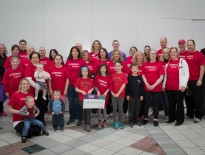
Rick Dimino
Metropolitan Boston continues to experience increased jobs, population growth and relocation of companies into the urban core. The strongest economic activity is taking place in the South Boston Waterfront area, living up to the predictions and expectations set years ago. Public infrastructure improvements over the past three decades transformed this area into an attractive place for redevelopment, new businesses and continued support for maritime activity. While there are obvious concerns regarding the transportation network’s ability to handle this growth, there are many positive steps taking place right now that will continue to support the mobility needs for the public and private sector in the Seaport District.
The Central Artery tunnel and the cleanup of Boston were both large and instrumental projects to build a platform for the Seaport area’s success. The Ted Williams tunnel and the road’s interchange in the Seaport enhanced access to and from this area. The construction of the Silver Line tunnel from South Station helped provide essential commuter access, while the creation of the South Boston Bypass road established trucking industry routes that avoided neighborhood roads. The public sector also funded the Moakley Courthouse and the Boston Convention & Exhibition Center as key early tenants. As a result of these projects, the spaces where large surface parking lots once existed are now the homes to modern commercial office space, residential buildings, and the private sector companies leading the 21st century economy.
Steps Already Taken
Additional positive steps and projects will occur later this month. Silver Line service to South Station will now reach Chelsea, marking the first major expansion of MBTA service in 10 years. This new route will include four new Silver Line stations in Chelsea – one with a connection for the Rockport /Newburyport commuter rail line – and a stop at the MBTA Airport Station for the Blue Line, followed by three stops in the Seaport District. This route will give commuters a one-seat ride through this corridor into Boston’s fastest growing job center; a dramatic change for workers who currently face multiple transfers between bus, subway or commuter rail systems, or a lengthy walk through Downtown Boston.
The city of Boston is beginning a construction project in April along Summer Street near the Fort Point Channel to establish protected bicycle lanes, rebuild bus station areas and produce accessible sidewalks. A future phase of this project will extend these bike lanes into the neighborhoods of South Boston. For vehicle traffic, MassDOT is preparing upgrades to the traffic signals at 39 intersections in the area. These “adaptive signals” will help to improve the management of all vehicular traffic through better advanced technology and equipment that can automatically coordinate of signal timing and lights throughout in the entire South Boston grid.
Finally, there is great potential for water ferries to avoid surface road congestion. The Massachusetts Convention Center Authority has developed a smart plan to harness private water ferry vessels for workers in the Seaport area, while also making this service available to the public. Bids have been submitted and a contract will be awarded to construct a modern pier at Lovejoy Wharf for travelers to and from North Station. This project is funded in part by state infrastructure dollars and mitigation funds provided by Related Beal. Once this dock is ready in late summer, a water ferry pilot program – funded by the private sector – is already set to begin. In future years, it is a safe bet to assume water ferry service will be expanded and this will be a highly utilized connection between North Station and the Seaport.
Steps to Take Tomorrow
Today, there is much more to do to meet the future needs of the district. One manageable solution is the use of the South Boston Bypass Road. The road was initially restricted to commercial trucks needing direct access to the Seaport and Massport’s Conley terminals. With the evolution of the waterfront towards a popular destination for thousands of additional workers and many businesses that are unrelated to maritime activities, it is time to open this road to non-commercial vehicles during peak commuting times. MassDOT tested this idea in a six-month experiment that ended in 2017. They have determined there is sufficient capacity to handle both types of vehicles without overburdening the road. While this would require federal approval to reopen this road to the public, it is an important thruway for vehicles traveling from the south of Boston and a reasonable measure for the workers in the Seaport. Maximizing its use should be the top goal in 2018 and beyond.
Going forward, funds do need to be identified for the additional transportation, mobility and resiliency investments that support this area. Similar to the list of previous bold infrastructure projects, the cost may be substantial, but so are the long-term benefits. There is history and tradition of infrastructure that have transformed this area and the economy of the commonwealth. Let’s keep taking the additional steps forward.
Rick Dimino is president and CEO of A Better City.




 |
| 
